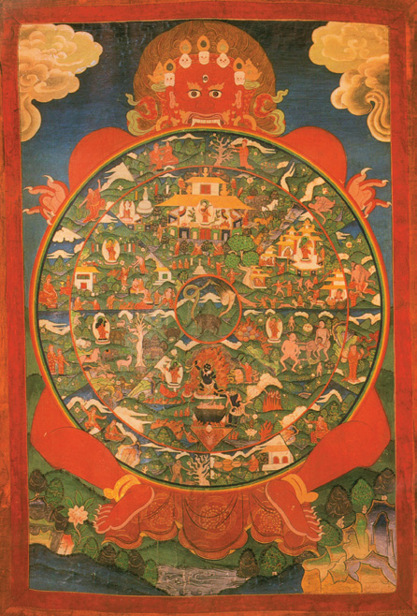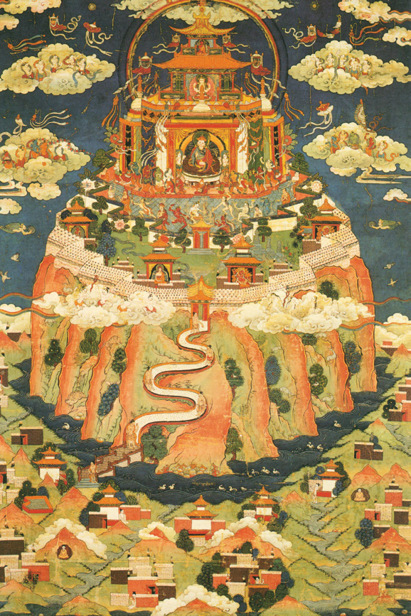An Illustrated Outline of Buddhism: The Essentials of Buddhist Spirituality (15 page)
Read An Illustrated Outline of Buddhism: The Essentials of Buddhist Spirituality Online
Authors: William Stoddart,Joseph A. Fitzgerald
Tags: #Philosophy

the relative. According to Buddhist doctrine, the principal hindrances
to the realization of
Nirvāna
are the five “attributes of individuality”
(
skandha
s).
These are:
body (
rūpa
)
sensations (
vedanā
)
thoughts (
samjñā
)
desires (
samskāra
)
individual consciousness (
vijñāna
)
Opposite page
: Gautama Buddha, Gupta Dynasty, Sārnāth, India

40
An Illustrated Outline of Buddhism
The five
skandha
s
cause man to be susceptible to the three
klesha
s
(“poisons” or “passions”), which are the very source of suffering (
duh-
kha
).
These are:
ignorance or il usion (
moha
)
—
symbolized by a pig
greed or lust (
lobha
)
—
symbolized by a cock
anger or pride (
dvesha
)
—
symbolized by a snake
Illusion, lust, pride (“the world, the flesh, the devil”): these are the
basic existential veils—or moral evils—to which all others can be re-
duced. The three symbolic animals are usual y depicted swallowing
each other, thus indicating the apparently hopeless predicament of
those who are their dupes. The only release is in the merciful Buddha
and in the Way he preached: the Four Noble Truths and the Eightfold
Path. Thus may one transcend the
skandha
s
(egoism) and overcome
the
klesha
s
(passions), and so escape the thralldom of
samsāra
.
(For the
Mahāyāna
doctrine of the Bodhisattva
and the “six virtues” or
pāramitā
s,
see pp. 67-68 and 77.)
One who, through spiritual striving and the grace of the Buddha,
attains the virtuality or actuality of the state of
Nirvāna
is
known as
an
arhat
or
arhant
(Sanskrit, “worthy one”),
arahat
(Pali),
lohan
(Chinese), or
rakan
(Japanese). These terms may be loosely translated as
“saint”. There are of course many degrees and modes of union with
Ultimate Reality, and this is something of which Buddhism takes full
account.
Nirvāna
is as it were incarnated by the Buddha and this recal s
the famous formula of St. Irenaeus—the definitive expression of the
central role of the
Logos
in all spiritualities or mysticisms: “God be-
came man, so that man might become God.” In the case of Buddhism,
this may be paraphrased as follows:
Nirvāna
became
samsāra
, so
that
samsāra
might become
Nirvāna
.
This insight comes from Frithjof Schuon.2 Elsewhere Schuon
writes:
The invocation of the Buddha Amitābha
is
founded on a doc-
trine of redemption. Amitābha
is
the Light and the Life of
2 See “The Perennial Philosophy”, in
The Unanimous Tradition
,
ed. Ranjit Fernando (Colombo: Sri Lanka Institute of Traditional Studies, 1991), pp. 22-23.



The Nature and the Teachings of Buddhism
41
T’hanka
of the Wheel of Life (
Bhavachakramudrā
),
with the three
klesha
s represented at the center, Tibet






The Nature and the Teachings of Buddhism
43
the Buddha; in invoking Amitābha,
the devotee enters into a
golden halo of Mercy, he finds security in the blessed light of
that Name; he withdraws into it with perfect surrender and
also with perfect gratitude. The Name of Amitābha
carries the
devotee towards
Sukhāvatī
(“the Western Paradise”).3
This is a reference to the Buddha’s “Original Vow”, which plays a
central role in the Pure Land school (see pp. 79-80). The invocation
of the Name of the Buddha corresponds to the invocatory spiritual
methods of other religions, such as
japa-yoga
in Hinduism, the “Jesus